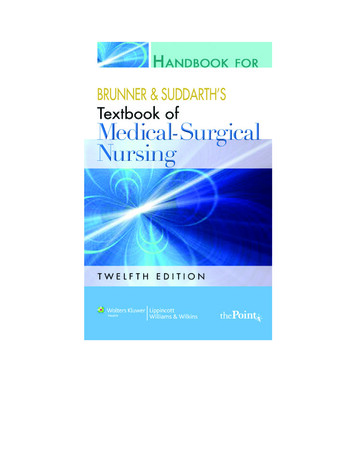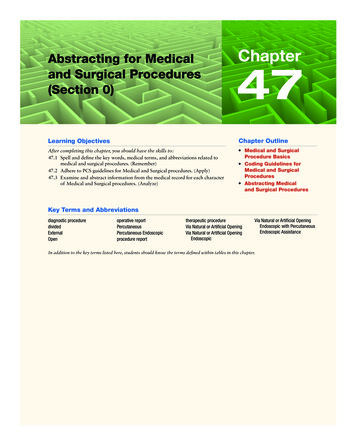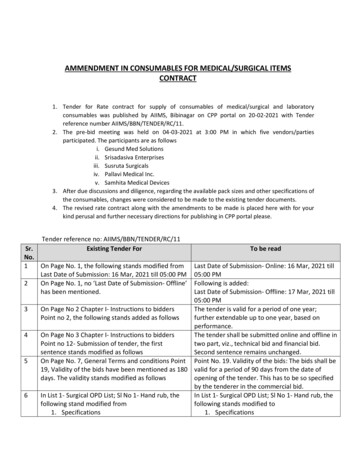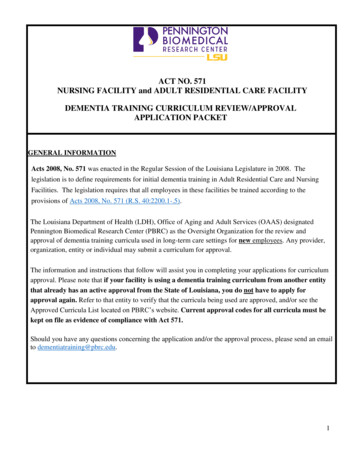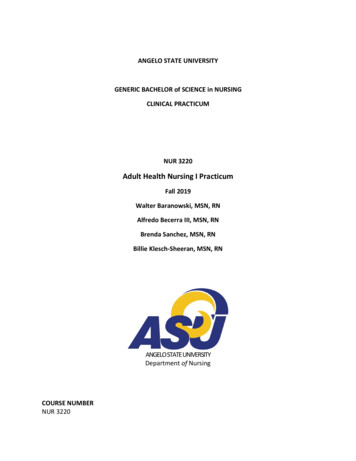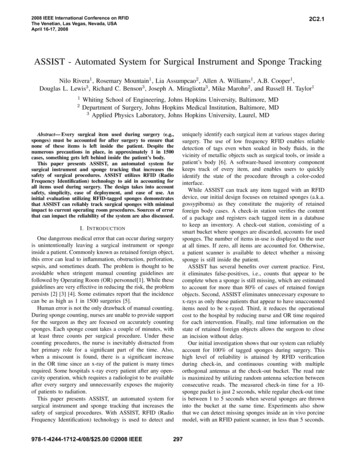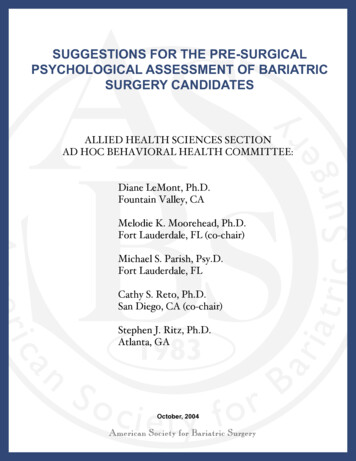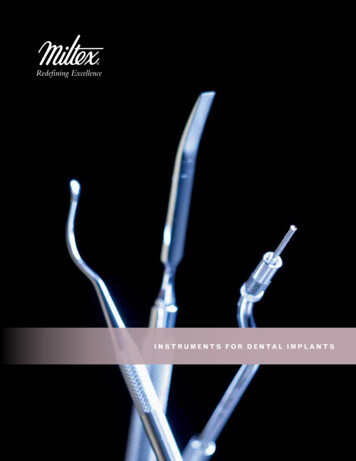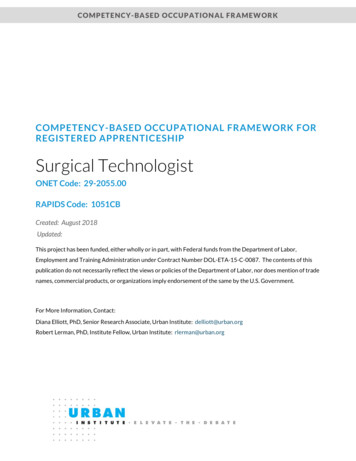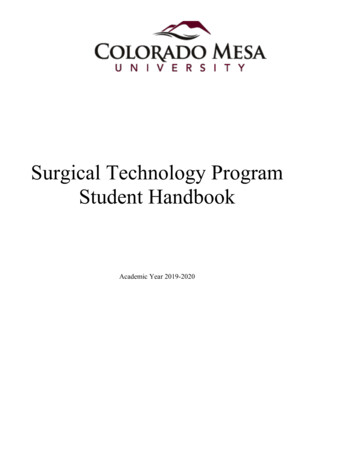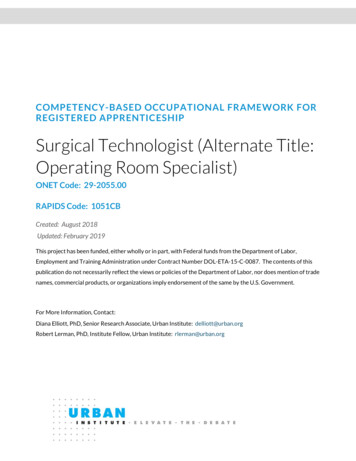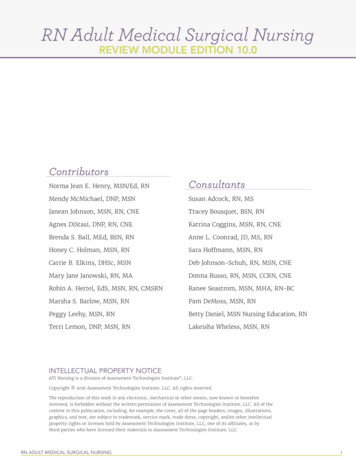
Transcription
RN Adult Medical Surgical NursingREVIEW MODULE EDITION 10.0ContributorsNorma Jean E. Henry, MSN/Ed, RNConsultantsMendy McMichael, DNP, MSNSusan Adcock, RN, MSJanean Johnson, MSN, RN, CNETracey Bousquet, BSN, RNAgnes DiStasi, DNP, RN, CNEKatrina Coggins, MSN, RN, CNEBrenda S. Ball, MEd, BSN, RNAnne L. Coonrad, JD, MS, RNHoney C. Holman, MSN, RNSara Hoffmann, MSN, RNCarrie B. Elkins, DHSc, MSNDeb Johnson-Schuh, RN, MSN, CNEMary Jane Janowski, RN, MADonna Russo, RN, MSN, CCRN, CNERobin A. Hertel, EdS, MSN, RN, CMSRNRanee Seastrom, MSN, MHA, RN-BCMarsha S. Barlow, MSN, RNPam DeMoss, MSN, RNPeggy Leehy, MSN, RNBetty Daniel, MSN Nursing Education, RNTerri Lemon, DNP, MSN, RNLakeisha Wheless, MSN, RNINTELLECTUAL PROPERTY NOTICEATI Nursing is a division of Assessment Technologies Institute , LLC.Copyright 2016 Assessment Technologies Institute, LLC. All rights reserved.The reproduction of this work in any electronic, mechanical or other means, now known or hereafterinvented, is forbidden without the written permission of Assessment Technologies Institute, LLC. All of thecontent in this publication, including, for example, the cover, all of the page headers, images, illustrations,graphics, and text, are subject to trademark, service mark, trade dress, copyright, and/or other intellectualproperty rights or licenses held by Assessment Technologies Institute, LLC, one of its affiliates, or bythird parties who have licensed their materials to Assessment Technologies Institute, LLC.RN ADULT MEDICAL SURGICAL NURSING I
Director of content review: Kristen LawlerDirector of development: Derek PraterProject management: Janet Hines, Nicole BurkeCoordination of content review: Norma Jean E. Henry, Mendy McMichaelCopy editing: Kelly Von Lunen, Derek PraterLayout: Spring Lenox, Randi HardyIllustrations: Randi HardyOnline media: Morgan Smith, Ron Hanson, Nicole Lobdell, Brant StacyCover design: Jason BuckInterior book design: Spring LenoxIMPORTANT NOTICE TO THE READERAssessment Technologies Institute, LLC, is the publisher of this publication. The content of this publication is forinformational and educational purposes only and may be modified or updated by the publisher at any time. Thispublication is not providing medical advice and is not intended to be a substitute for professional medical advice,diagnosis, or treatment. The publisher has designed this publication to provide accurate information regarding thesubject matter covered; however, the publisher is not responsible for errors, omissions, or for any outcomes related tothe use of the contents of this book and makes no guarantee and assumes no responsibility or liability for the use of theproducts and procedures described or the correctness, sufficiency, or completeness of stated information, opinions, orrecommendations. The publisher does not recommend or endorse any specific tests, providers, products, procedures,processes, opinions, or other information that may be mentioned in this publication. Treatments and side effects describedin this book may not be applicable to all people; likewise, some people may require a dose or experience a side effectthat is not described herein. Drugs and medical devices are discussed that may have limited availability controlled bythe Food and Drug Administration (FDA) for use only in a research study or clinical trial. Research, clinical practice,and government regulations often change the accepted standard in this field. When consideration is being given to useof any drug in the clinical setting, the health care provider or reader is responsible for determining FDA status of thedrug, reading the package insert, and reviewing prescribing information for the most up-to-date recommendationson dose, precautions, and contraindications and determining the appropriate usage for the product. Any referencesin this book to procedures to be employed when rendering emergency care to the sick and injured are provided solelyas a general guide. Other or additional safety measures may be required under particular circumstances. This bookis not intended as a statement of the standards of care required in any particular situation, because circumstancesand a patient’s physical condition can vary widely from one emergency to another. Nor is it intended that this bookshall in any way advise personnel concerning legal authority to perform the activities or procedures discussed. Suchspecific determination should be made only with the aid of legal counsel. Some images in this book feature models.These models do not necessarily endorse, represent, or participate in the activities represented in the images. THEPUBLISHER MAKES NO REPRESENTATIONS OR WARRANTIES OF ANY KIND, WHETHER EXPRESS OR IMPLIED, WITHRESPECT TO THE CONTENT HEREIN. THIS PUBLICATION IS PROVIDED AS-IS, AND THE PUBLISHER AND ITS AFFILIATESSHALL NOT BE LIABLE FOR ANY ACTUAL, INCIDENTAL, SPECIAL, CONSEQUENTIAL, PUNITIVE, OR EXEMPLARYDAMAGES RESULTING, IN WHOLE OR IN PART, FROM THE READER’S USE OF, OR RELIANCE UPON, SUCH CONTENT.IICONTENT MASTERY SERIES
User’s GuideWelcome to the Assessment Technologies Institute RNAdult Medical Surgical Nursing Review Module Edition10.0. The mission of ATI’s Content Mastery Series ReviewModules is to provide user-friendly compendiums ofnursing knowledge that will: Help you locate important information quickly. Assist in your learning efforts. Provide exercises for applying your nursing knowledge. Facilitate your entry into the nursing profession as anewly licensed nurse.This newest edition of the Review Modules has beenredesigned to optimize your learning experience. We’vefit more content into less space and have done so in away that will make it even easier for you to find andunderstand the information you need.ORGANIZATIONThis Review Module is organized into units covering thefoundations of nursing care (Unit 1), body systems andphysiological processes (Units 2 to 13), and perioperativenursing care (Unit 14). Chapters within these unitsconform to one of three organizing principles forpresenting the content. Nursing concepts Procedures System disordersNursing concepts chapters begin with an overviewdescribing the central concept and its relevance to nursing.Subordinate themes are covered in outline form todemonstrate relationships and present the information ina clear, succinct manner.Procedures chapters include an overview describingthe procedure(s) covered in the chapter. Thesechapters provide nursing knowledge relevant to eachprocedure, including indications, nursing considerations,interpretation of findings, and complications.System disorders chapters include an overview describingthe disorder(s) and/or disease process. These chaptersaddress assessments, including risk factors, expectedfindings, laboratory tests, and diagnostic procedures.Next, you will focus on patient-centered care, includingnursing care, medications, therapeutic procedures,interprofessional care, and client education. Finally, youwill find complications related to the disorder, along withnursing actions in response to those complications.ACTIVE LEARNING SCENARIOSAND APPLICATION EXERCISESEach chapter includes opportunities for you to test yourknowledge and to practice applying that knowledge. ActiveLearning Scenario exercises pose a nursing scenarioand then direct you to use an ATI Active LearningTemplate (included at the back of this book) to recordthe important knowledge a nurse should apply to thescenario. An example is then provided to which you cancompare your completed Active Learning Template. TheApplication Exercises include NCLEX-style questions, suchas multiple-choice and multiple-select items, providingyou with opportunities to practice answering the kinds ofquestions you might expect to see on ATI assessments orthe NCLEX. After the Application Exercises, an answer keyis provided, along with rationales.NCLEX CONNECTIONSTo prepare for the NCLEX-RN, it is important tounderstand how the content in this Review Moduleis connected to the NCLEX-RN test plan. You can findinformation on the detailed test plan at the NationalCouncil of State Boards of Nursing’s website, www.ncsbn.org. When reviewing content in this Review Module,regularly ask yourself, “How does this content fit intothe test plan, and what types of questions related to thiscontent should I expect?”To help you in this process, we’ve included NCLEXConnections at the beginning of each unit and with eachquestion in the Application Exercises Answer Keys. TheNCLEX Connections at the beginning of each unit pointout areas of the detailed test plan that relate to the contentwithin that unit. The NCLEX Connections attached to theApplication Exercises Answer Keys demonstrate how eachexercise fits within the detailed content outline.These NCLEX Connections will help you understand howthe detailed content outline is organized, starting withmajor client needs categories and subcategories andfollowed by related content areas and tasks. The majorclient needs categories are: Safe and Effective Care Environment Management of Care Safety and Infection Control Health Promotion and Maintenance Psychosocial Integrity Physiological Integrity Basic Care and Comfort Pharmacological and Parenteral Therapies Reduction of Risk Potential Physiological AdaptationAn NCLEX Connection might, for example, alert you thatcontent within a unit is related to: Reduction of Risk Potential Diagnostic Tests Monitor the results of diagnostic testing andintervene as needed.RN ADULT MEDICAL SURGICAL NURSINGUSER’S GUIDEIII
QSEN COMPETENCIESAs you use the Review Modules, you will note theintegration of the Quality and Safety Education forNurses (QSEN) competencies throughout the chapters.These competencies are integral components of thecurriculum of many nursing programs in the United Statesand prepare you to provide safe, high-quality care as anewly licensed nurse. Icons appear to draw your attentionto the six QSEN competencies.Safety: The minimization of risk factors that couldcause injury or harm while promoting quality careand maintaining a secure environment for clients, self,and others.Patient-Centered Care: The provision of caring andcompassionate, culturally sensitive care that addressesclients’ physiological, psychological, sociological, spiritual,and cultural needs, preferences, and values.Evidence-Based Practice: The use of current knowledgefrom research and other credible sources, on which to baseclinical judgment and client care.Informatics: The use of information technology as acommunication and information-gathering tool thatsupports clinical decision-making and scientifically basednursing practice.Quality Improvement: Care related and organizationalprocesses that involve the development andimplementation of a plan to improve health care servicesand better meet clients’ needs.Teamwork and Collaboration: The delivery of client carein partnership with multidisciplinary members of thehealth care team to achieve continuity of care and positiveclient outcomes.ICONSIcons are used throughout the Review Module to drawyour attention to particular areas. Keep an eye out forthese icons.This icon is used for NCLEX Connections.This icon indicates gerontological considerations,or knowledge specific to the care of olderadult clients.This icon is used for content related to safetyand is a QSEN competency. When you see thisicon, take note of safety concerns or steps thatnurses can take to ensure client safety and asafe environment.This icon is a QSEN competency that indicatesthe importance of a holistic approach toproviding care.This icon, a QSEN competency, points out theintegration of research into clinical practice.This icon is a QSEN competency and highlightsthe use of information technology to supportnursing practice.This icon is used to focus on the QSENcompetency of integrating planning processes tomeet clients’ needs.This icon highlights the QSEN competency of caredelivery using an interprofessional approach.This icon appears at the top-right of pagesand indicates availability of an online mediasupplement, such as a graphic, animation, orvideo. If you have an electronic copy of theReview Module, this icon will appear alongsideclickable links to media supplements. If you havea hard copy version of the Review Module, visitwww.atitesting.com for details on how to accessthese features.FEEDBACKATI welcomes feedback regarding this Review Module.Please provide comments to comments@atitesting.com.IVUSER’S GUIDECONTENT MASTERY SERIES
Table of ContentsNCLEX Connections1UNIT 1Foundations of Nursing Carefor Adult ClientsCHAPTER 1Health, Wellness, and Illness3Health and wellness 3IllnessCHAPTER 2Emergency Nursing Principles and ManagementNCLEX ConnectionsUNIT 2715Nursing Care of Clients Who HaveNeurosensory DisordersSECTION:CHAPTER 34Diagnostic and Therapeutic ProceduresNeurologic Diagnostic Procedures17Cerebral angiography 17Cerebral computed tomography scan 18ElectroencephalographyGlasgow Coma Scale1819Intracranial pressure monitoring 19Lumbar puncture (spinal tap) 20Magnetic resonance imaging scan 21PET and SPECT scans22Radiography (x‑ray) 22CHAPTER 4Pain ManagementRN ADULT MEDICAL SURGICAL NURSING25TABLE OF CONTENTSV
SECTION:Central Nervous System DisordersCHAPTER 5Meningitis31CHAPTER 6Seizures and Epilepsy35CHAPTER 7Parkinson’s Disease41CHAPTER 8Alzheimer’s Disease45CHAPTER 9Brain Tumors49CHAPTER 10Multiple Sclerosis55CHAPTER 11Headaches59Migraine headachesCluster headachesSECTION:CHAPTER 125960Sensory DisordersDisorders of the EyeMacular degeneration6363Cataracts 63GlaucomaCHAPTER 13Middle and Inner Ear DisordersSECTION:VI6569Neurologic EmergenciesCHAPTER 14Head Injury75CHAPTER 15Stroke81CHAPTER 16Spinal Cord Injury87TABLE OF CONTENTSCONTENT MASTERY SERIES
NCLEX ConnectionsUNIT 395Nursing Care of Clients WhoHave Respiratory DisordersDiagnostic and Therapeutic ProceduresSECTION:CHAPTER 17Respiratory Diagnostic Procedures97P
NCLEX Connections at the beginning of each unit point out areas of the detailed test plan that relate to the content within that unit. The NCLEX Connections attached to the Application Exercises Answer Keys demonstrate how each exercise fits within the detailed content outline. These NCLEX Connections will help you understand how the detailed content outline is organized, starting with major .
